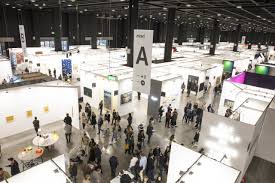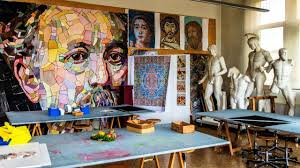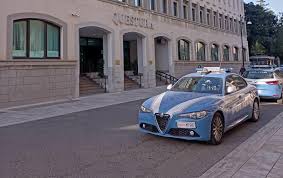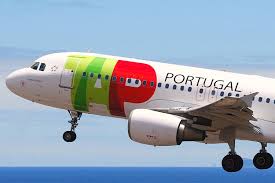Miart is Italy’s biggest fair—can it be its best?

A palpable buzz was felt in sunny Milan in mid-April. Well-heeled and international crowds had descended on the affluent Lombardy capital. Some were in town for Milan Design Week, others for the Venice Biennale, a two-hour train ride away. Many also arrived for Miart contemporary art fair, which ran from 10 to 14 April.
With this edition, the fair’s director, Nicola Riccardi, has “finally figured out the Miart formula”, he says. He began in the role in 2020, as the world entered its first Covid-19 lockdown—“the absolute worst time to be a fair director”.
Under his tenure, Miart has seen successive double-digit increases since its boutique-sized 2021 edition, of 140 galleries. Now at 178, it stands as Italy’s biggest contemporary art fair by exhibitor numbers, and is almost back to 2019 exhibitor levels of 190. That year, heavyweight international galleries like Hauser & Wirth and Thaddaeus Ropac took part for the first time, keen to test out whether Milan’s then-recently implemented income tax cuts for wealthy internationals would transform the city’s art market. They haven’t returned, indicating the market is not deep enough to absorb a critical mass of blue chip art. “I discouraged Michael Werner gallery from applying this year,” Riccardi says. “Michael [Werner] wanted to bring works from €150,000 upwards, but Milan and this fair are not there yet.”
Indeed, Riccardi says that rather than expanding further and chasing big names, he wants to double down on curatorial projects, such as Timescape, a new six-gallery micro-section showing art connected to the early 20th century. Riccardi says he is now considering a Frieze Masters-style section for next edition.
Moreover, he is underlining his commitment to the fair’s emerging section, which last year he wisely moved to the entrance of the fair, forcing visitors to spend their first minutes in the fair encountering new faces. Newcomers to this section include the esteemed Arcadia Missa and the recently established Gathering, both from London. They join curatorially daring ventures such as Matta from Milan, Bel Ami from Los Angeles and New York’s Ashes/Ashes, which brought paintings and sculptures by the Italian artist Michele Gabriele. Signalling Miart’s success in fostering growth within its participants, four galleries from last year’s emerging section have now graduated to the main section, including Olympia from New York and Rome’s Ada.
Thanks to Riccardi’s work, as well as those of his two predecessors, Vincenzo de Bellis and Alessandro Rabottini, who ran the fair from 2013 to 2016, and 2017 to 2020, respectively, Miart has built a quiet reputation for spotlighting cutting edge contemporary art and spotting early talents. Case in point, this year’s emerging stand prize winner is Roland Ross from Margate—a name that is likely unfamiliar to many, as this is the gallery’s first fair.
Still, while Miart might be steadily cultivating a reputation for talent spotting it is greatly overshadowed in this respect by Artissima, the contemporary art fair in northwestern Italy’s other industrial powerhouse city, Turin. Many of these emerging gallerists note that the two fairs fill similar roles. “You have to make a choice,” says Miart exhibitor Marie Madec, the co-founder of Sans Titre in Paris. The gallery sold half its stand by VIP day, including erotic wallpapers by Robert Brambora. “For us Milan is a chance to connect to fashion and design clients,” Madec says. “It’s invaluable for that reason.”
While Riccardi acknowledges the inevitability of the comparison between the two fairs, he points out that they offer different things. “Miart is more market focused. Galleries know they won’t sell well at Artissima, although if they do, that’s great. And Artissima has a stronger reputation for bringing over curators. We can work together.”
Speaking of the market, top line sales from Miart’s preview day include a 1987 Hockney screen by Lelong for €580,000. And one of the strongest presentations from the main section comes from a first timer, Buccholz from Berlin, which showed large Isa Genzken work fresh from her major show at the Neue Nationalgalerie in Berlin, and vast painting by Lutz Bacher. The gallery’s effort paid off as it was awarded the stand prize for the main section.
From the VIPs in attendance—including Uli Sign and Patrizia Sandretto Re Rebaudengo—to the wealth of cultural activities to do outside the fair, the draws of Milan are made clear in Miart. The market here is certainly helped by a great (and growing) culture of corporate patronage, best exemplified by the Prada, Trussardi and Pirelli contemporary art foundations, each of which put on major exhibitions timed to Milan Art Week.
Also apparent in certain absences are Milan’s enduring downfalls. The city’s long-promised public museum for contemporary art is still nowhere to be seen (of Western Europe’s ten biggest cities, only Milan lacks a state-funded institution for art of the late 20th- and 21st centuries). Slated for 2024, Riccardi hopes when it finally opens it will begin collecting seriously and buy from the fair. However, the museum is a national state project, he says, and is subject to forces greater than those of the city of Milan. And with Italy still being ruled by a far-right government, Milan’s art market concerns might be the least of anyone’s worries.





